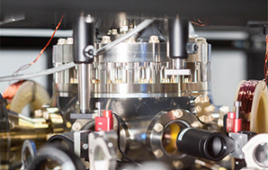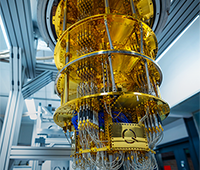Parallel Processing Expert Christopher Carothers
Named Director of Rensselaer Supercomputing
Center

Christopher Carothers |
The combination of powerful new hardware, a talented new
director, and a continued industry focus is set to amplify the
success, reach, and impact of the Rensselaer Polytechnic Institute
supercomputing center.
Parallel and distributed computing expert Christopher
Carothers has been named director of the Rensselaer Computational Center for
Nanotechnology Innovations (CCNI). In this role, Carothers
is charged with making the new supercomputing resources of CCNI
accessible to Rensselaer students and faculty. He is also
responsible for forging new collaborations and opportunities
for Rensselaer researchers to continue solving critical
high-performance computing problems and creating value for the
center’s partners in industry, academia, and government.
“High-performance computing enables a great many research
programs at Rensselaer, ranging from nanoscale and
molecular-level investigations into understanding protein
structure and function to macroscale endeavors such as
designing new aircraft wings. CCNI is both a research platform
and a differentiator that helps to attract the brightest
students, researchers, and faculty to Rensselaer,” said Jonathan
Dordick, vice president for research at Rensselaer. “Dr.
Carothers is an outstanding academic leader and a talented
researcher. We are confident that Chris will chart an exciting
course for CCNI to follow and we look forward to his leadership
and vision for the next chapter of supercomputing at
Rensselaer.”
“Chris Carothers is a dynamic leader in the area of
massively parallel computing, leading CCNI’s mission of working
with industrial and academic partners to explore the potential
of high-performance computing, and expand the use of our
supercomputing resources,” said John
Kolb, vice president for information services and
technology and chief information officer at Rensselaer. “The
efforts of CCNI, under Chris’ leadership, will help position
New York and the United States as global leaders in modeling
and simulation-based research and development, scientific
discovery, technological innovation, and advanced
manufacturing.”
“Supercomputing touches—or will soon touch—nearly every
discipline, from science and engineering to finance, social
sciences, and the arts. The importance of this technology
cannot be overstated,” said Carothers, also a
professor in the Department of Computer
Science at Rensselaer. “The central mission of CCNI is
solving problems for next-generation basic and applied science
and engineering research through the use of massively parallel
computation and data analytics. By solving these complex
computational problems, CCNI is a transformative tool for
research, education, and industrial application for Rensselaer,
New York state, and the nation.”
Industry Focus
Since opening in 2007 as the world’s seventh largest
supercomputer, CCNI has enabled researchers at Rensselaer and
around the country to tackle challenges ranging from advanced
manufacturing to cancer screening to sustainable energy. CCNI
is a $100 million partnership among Rensselaer, IBM, and New
York state. The center currently supports a network of more
than 850 researchers, faculty, and students from 50
universities, government laboratories, and companies across a
diverse spectrum of disciplines.
In many cases, CCNI empowers these researchers to perform
advanced calculations, modeling, or simulations and generate
results within a few hours, instead of waiting years for less
powerful computers to complete the same tasks. CCNI is also a
resource for the growing number of companies that use or are
interested in using high-performance computing as a way to
create and sustain competitive advantage. Rensselaer experts
assist these companies in translating their design,
engineering, and manufacturing challenges into problems that
can be tackled by a supercomputer.
In partnership with the Rensselaer Scientific Computation
Research Center (SCOREC) and New York state’s High Performance Computing
Consortium (HPC2), CCNI works with New York
companies to optimize current products, design next-generation
technologies, and train staff in the methods and best-practices
of high-performance computing. Working with a range of
businesses, from Fortune 50 firms to start-ups with three
employees, CCNI and its partners help companies decrease
product development cycle times, improve quality of products,
reduce costs, and boost their ability to compete in the global
marketplace—all without having to invest in or acquire their
own supercomputing systems.
Rensselaer has worked with hundreds of users and dozens of
companies to this end, from local engineering software maker
Simmetrix and silver salts manufacturer Ames Goldsmith to New
York state-based technology leaders Xerox, IBM, and
Corning.
One of Carothers’ first endeavors as director of CCNI is
traveling to Supercomputing, the International Conference for
High Performance Computing, Networking, Storage, and
Analysis, this week in Salt Lake City to network with the
high-performance computing community and host an informational
session with potential partners and collaborators in industry,
academia, and government.
Powerful Hardware
CCNI opened its doors in 2007 with 16 racks of IBM
Blue Gene/L supercomputers and other machines with a combined
total of more than 100 teraflops of computing power—one
teraflop is the ability to perform one trillion, or
1012, floating point operations per second. This
summer, the center installed a new 200-teraflop system
comprised of a powerful IBM Blue Gene/Q supercomputer. Along
with the Blue Gene/Q, the new system features a multi-terabyte
memory (RAM) storage accelerator, petascale disk storage,
rendering cluster, remote display wall systems, and other
components. The result is a machine with a balanced combination
of computational power, fast data access, and visualization
capabilities.
The new Blue Gene/Q system was funded primarily by a $2.65
million grant from the National Science Foundation (NSF). The
new Blue Gene/Q component of the system boasts more than twice
the computational power than the center’s 16 racks of Blue
Gene/L, while taking up less than 1/10th of the
space and using only 1/6th of the electrical power
to operate. However, the true power of the new Blue Gene/Q
system at Rensselaer is its balance; it is many times faster
than the Blue Gene/L system on data-intensive problems, and the
combination of computation, fast data access, and visualization
supports a significantly broader scope of research.
The new Blue Gene/Q system is the result of the ongoing
strong partnership between Rensselaer and IBM, both of which
are committed to moving forward and pushing the boundaries of
high-performance computing technology.
Innovative Research
CCNI and high-performance computing are boosting the
ability of Rensselaer faculty and students to advance their
leading-edge research. Scientific and engineering studies are
generating more data than ever before, and there is a rapidly
growing need to interact with more of this data in increasingly
meaningful ways. CCNI’s supercomputing systems, in the hands of
Rensselaer student and faculty experts, are powerful tools to
help researchers across nearly all academic disciplines and
industrial sectors overcome this challenge.
Access to CCNI and its supercomputers is a key asset and
differentiator for Rensselaer faculty researchers seeking
funding from the federal government and other organizations. In
September, for example, a team of nuclear engineers and
computer scientists at Rensselaer secured a $2.6 million grant
from the NSF to investigate how computer video cards could be
connected to make inexpensive supercomputers for medical
imaging departments at hospitals. In two NSF Faculty Early
Career Development (CAREER) awards totaling more than $1
million, one young researcher received funding to advance
research into the design of nanomaterials for use in nuclear
energy systems, while the other received funds to investigate
the swimming behavior of bacteria and other microorganisms.
Another study, funded by New York state and the NSF, used
large-scale quantum simulations to characterize the ability of
graphene—the thinnest material in the world—to transmit
electricity, for use in next-generation electronics.
The proposals for all of these grants and projects—and many
others—leveraged the computational strength and researcher
expertise of CCNI. Over the past five years, nearly $50 million
in external research funding has been attributed to CCNI.
Approaching the Exascale
Researchers at Rensselaer are known for developing
highly scalable parallel processing and distributed processing
techniques that allow computer modeling to be done across
hundreds of thousands of processors. The Blue Gene/Q system
furthers their capabilities and provides a platform for
exploring and creating new techniques that will be broadly
applicable to exascale computing. Experts in academia and
industry anticipate realizing exascale computing—performing
1018 calculations per second—by the end of the
decade. Exascale machines will have 50 times the computational
power of today’s largest machines.
The new Blue Gene/Q system at Rensselaer will be a first
stop for many researchers looking to scale up their research
over the next decade. Once they adapt their project to work on
the Rensselaer system, they will be well-positioned to migrate
over to the larger petascale and future exascale systems
installed at national laboratories. Interacting with other
experts from across the country and around the world will help
to ensure that Rensselaer students and faculty members continue
to be at the front lines of developing extreme-scale computing
techniques and defining next-generation computing problems in
academia and industry.
Dynamic Leadership
As the new director of CCNI, Carothers will oversee a
staff of computational scientists and system administrators at
the supercomputer center’s facility in the Rensselaer
Technology Park in East Greenbush. He joined the Rensselaer
faculty as an assistant professor in 1998, was named an
associate professor in 2004, and a full professor in 2010.
Carothers’ research interests are in the areas of massively
parallel systems with a focus on the modeling and simulation of
complex systems. Since joining Rensselaer, he has secured about
$7 million in research funding from agencies including the NSF,
the U.S. Department of Energy, Army Research Laboratory, Air
Force Research Laboratory, as well as several companies,
including IBM, General Electric, and AT&T. His simulation
research involves the creation of high-fidelity models of
extreme-scale wireless and wired networks and computer systems.
These models have executed using more than 100,000
processors.
Active in his professional community, Carothers has served
as associate editor of the journals SIMULATION:
Transactions of the Society for Modeling and Simulation
International and ACM Transactions on Modeling and
Computer Simulation. He is also an active reviewer for
several publications. Carothers is a member of the Association
for Computing Machinery and a member of the IEEE Computer
Society.
Carothers received a best paper award at the 2009 Workshop
on Principals of Advanced and Distributed Simulation. He also
won best paper awards at the 2003 and 1999 Workshop on Parallel
and Distributed Simulation. He received a NSF CAREER Award in
2002, as well as the MITRE Program Recognition Award for
contributions on the U.S. Department of Defense High Level
Architecture (HLA) project.
He received his bachelor’s, master’s, and doctoral degrees,
all in computer science, from the Georgia Institute of
Technology.



